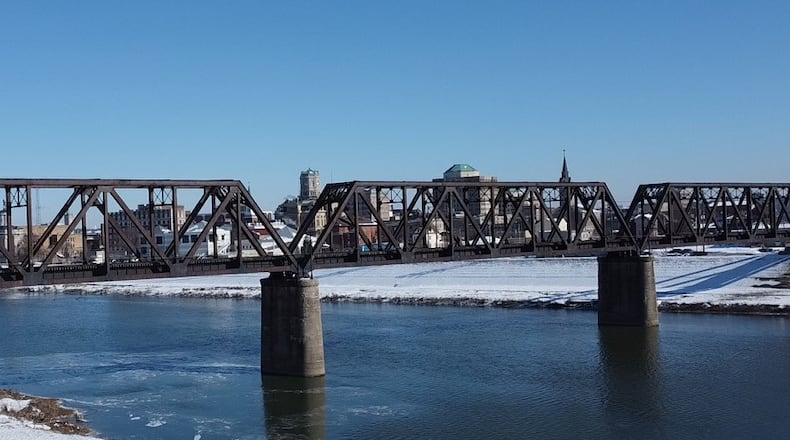Progress on the road would slow until the appointment of Hamiltonian John Woods as president in 1852. Woods had recently left office as Ohio’s Auditor of State, and was instrumental in arranging the financing of the railroad. The Junction Railroad would consolidate with the Ohio & Indianapolis Railroad in 1853, and for marketing purposes, taking the name, the Cincinnati & Indianapolis Railroad.
The current bridge we see today is actually the fourth in this location. The first bridge was designed by John S. Earhart, a Hamilton civil engineer who also completed the initial survey of the line from Hamilton to Oxford. A competing railroad, the Four Mile Valley held the preferred right of way, thus requiring the Junction to build through more challenging territory involving significant elevation changes and additional expense. The organizers of the Four Mile Valley Railroad would eventually abandon their efforts after completing a limited amount of construction.
Earhart decided the steep elevation into Rossville, now known as West Hamilton, required a high approach from East Hamilton. Thus, an embankment starting at South Front Street and a 655-foot stone viaduct carried the road into Rossville. The bridge and the 17 stone arches on Hamilton’s West side were completed in 1858.
This bridge was of wood construction with metal sheeting. The exterior of the stone arches came from the Scott quarries in Dayton, while the interior stone of each arch came from the C.K. Smith farm at the mouth of the Four Mile Creek in Seven Mile, Ohio.
In 1872, the Junction Railroad was acquired by the Cincinnati, Hamilton & Dayton Railroad and renamed the Cincinnati, Hamilton & Indianapolis, eventually becoming part of the current CSX Railroad.
The first bridge was made obsolete as the increasing size of railroad locomotives and rolling stock necessitated a stronger structure, and thus was replaced with an iron bridge in November of 1893. This second bridge, built by the Detroit Bridge & Iron Company, was destroyed in the Great Miami River flood of 1913.
A third and temporary wooden bridge was built to keep traffic on the line moving during the remainder of 1913. In turn, the fourth and more permanent structure, the current bridge we see today, was constructed by the American Bridge Company and was started later in 1913.
This three span, through truss bridge with riveted connections, utilizes the original stone arch viaduct of 1858. It is interesting to note, so pressing was the need for a permanent replacement, that the bridge was opened to rail traffic in January, 1914 with only 35% of the riveting, used to hold sections of the bridge together, having been completed.
Given the difficulty of building replacements for the High Street, Black Street and Columbia bridges in Hamilton after the 1913 Flood, a proposal was made to attach a steel footbridge to this newly completed structure. As noted in the Hamilton Evening Journal, the footbridge would be sufficient for “a small child or drunken man to cross safely”. According to subsequent reports, the proposed footbridge was never completed.
Today, the traffic on this bridge is limited to only a few trains per day, most notably the Amtrak Cardinal and a few general merchandise trains. This is due to height restrictions caused by the “D” and “G” street overpasses on Hamilton’s West side that have insufficient clearance for double stack container and car carrier traffic.
Jim Krause is the author of the newly published book “Wreck of the Cincinnati, Hamilton & Dayton Railway – A Pioneering Railroad Undone by Greed and Fraud”, available for purchase at the Butler County Historical Society. He can be reached at jdkrause@fuse.net.
About the Author




